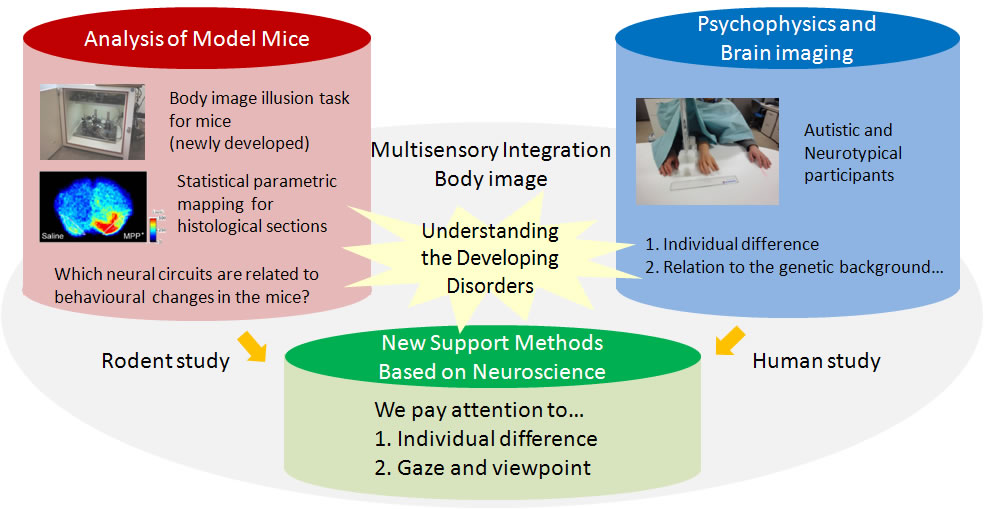| |
We study multisensory integrations and body images in the brain of persons with developmental disorders by using physiological, psychological and histological methods. We intend to apply our research outcomes to medical and social supports for persons with developmental disorders.
In particular, we focus on three themes below.
- Analysis of mouse models of developmental disorders
- Psychophysics and brain imaging ( in human)
- Development of new support methods that are based on neuroscience
Neural basis of developmental disorders is still unclear. We would like to clarify the neural basis and develop innovative support methods for developmental disorders by using the outcomes. |
|
Members
Makoto WADA, MD & PhD (Chief)
Masakazu IDE, PhD (Researcher)
Takeshi ATSUMI, PhD (Research Fellow)
Mrinmoy CHAKRABARTY, PhD (Research Fellow)
Yumi UMESAWA, PhD (Research Fellow)
Taemi NAWA (Technical staff)
Naoko KUME (Technical staff)
Ari TANAKA (Technical staff)
Alumni
Ayako YAGUCHI (9.2015-3.2016, present post: Graduate school student, Rikkyo Univ)
Takao FUKUI (4.2014-3.2017, present post: Associate professor, Tokyo Metropolitan University)
Hanako IKEDA (4.2015-3.2017, present post: Researcher, Shiseido Co., Ltd)
|
|
|
Papers (English)
- Ide M‡ & Wada M‡. Salivary oxytocin concentration associates with the subjective feeling of body ownership during the rubber hand illusion. Frontiers in Human Neuroscience, 11:166, doi:10.3389/fnhum.2017.00166, 2017.
- Takemura N, Inui T & Fukui T. A Neural network model for development of reaching and pointing based on the interaction of forward and inverse transformations, Developmental Science, in press.
- Yamaguchi Y‡, Atsumi T‡, Poirot R‡, Lee YA, Kato A & Goto Y. Dopamine-dependent Visual Attention Preference to Social Stimuli in Non-human Primate. Psychopharmacology, 234(7): 1113–1120, 2017.
- Atsumi T, Koda H & Masataka N. Goal attribution to inanimate moving objects by Japanese macaques (Macaca fuscata). Scientific Reports, 7, 40033, 2017.
- Ide M, Hidaka S, Ikeda H & Wada M. Neural mechanisms underlying touch-induced visual perceptual suppression: An fMRI study. Scientific Reports, 6, 37301, 2016.
- Wada M, Takano K, Ora H, Ide M & Kansaku K. The Rubber Tail Illusion as Evidence of Body Ownership in Mice. Journal of Neuroscience, 36(43):11133-11137, 2016.
- Ide M & Wada M. Periodic visuotactile stimulation slowly enhances the rubber hand illusion in individuals with high autistic traits. Front. Integr. Neurosci. 10:21, 2016
- Ikeda, H & Watanabe K. Action congruency influences crowding when discriminating biological motion direction. Perception, 45(9):1046-1059, 2016.
- Wada M & Ide M. Rubber hand presentation modulates visuotactile interference effect, especially in persons with high autistic traits. Experimental Brain Research, 234(1):51-65, 2016. Epub 2015 Sep 10.
- Hidaka S & Ide M. Sound can suppress visual perception. Scientific Reports, 5,10483, 2015.
- Fukui T & Inui T. Use of early phase online vision for grip configuration is modulated according to movement duration in prehension. Experimental Brain Research, 233(8): 2257-2268, 2015
- Takemura T, Fukui T & Inui T. A computational model for aperture control in reach-to-grasp movement based on predictive variability, Frontiers in Computational Neuroscience, 9, 143, in press
- Nishikawa N‡, Shimo Y‡, Wada M‡, Hattori N & Kitazawa S. Effects of aging and idiopathic Parkinson’s disease on tactile temporal order judgment. PLOS ONE. 10(3) e0118331, 2015.
- Wada M, Suzuki M, Takaki A, Miyao M, Spence C & Kansaku K. Spatio-temporal processing of tactile stimuli in autistic children. Scientific Reports, 4:5985, 2014.
(‡ Equal contribution.)
|
|

